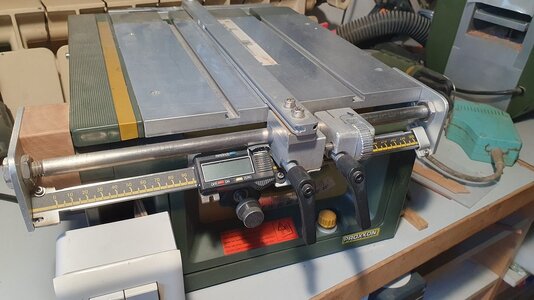Hi everyone,
I’m sharing pictures of my Proxxon FET saw fence upgrade.

For the longest time I’ve been driven crazy by the inability to get consistently even cuts with the saw, or to be able to quickly and reliably adjust the width of the cut.
The heart of the upgrade is this:
Befenybay 200mm linear rail

I used the 200mm NEMA 17 -version, but even the 250mm version should fit. As a CNC linear rail it is very accurate and has zero play in the screw thread. For my purposes the electric motor was not necessary so I removed it.
ASSEMBLY:
I’m afraid I only have pictures of the finished upgrade, but I’ll try and explain the process.
I removed the Proxxon FET fence and gauge assembly, removed the yellow front plate and sawed off the brackets using an angle grinder.

Using graph paper lightly glued to the back of the front plate, I marked and then drilled the holes for the linear rail.
The linear rail has t-nuts at the back which make it very easy to attach and slide into the right position.

Some of the green plastic of the top cover has to be removed for it to fit, but it does not affect the integrity of the green plastic cover.

I have no use for angled cuts and only want guaranteed square cuts, so I removed the black adjusting wheel and tightened it square with a nyloc nut. By removing the height locking screw I am also able to get more height when using a 50mm saw blade.
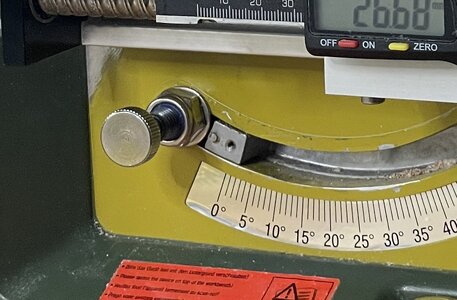
Note that the rail has to fit all the way past the table so that the fence is clear of the table when opening the cover (for changing blades etc):
The linear rail sits very nicely under the table. The gap between the top of the rail and the table is almost exactly 15mm.
I attached a piece of standard 15x25mm steel tubing to the rail using M4 screws, and then made M4 screw holes on the top of the tubing for the L-bracket for the fence.

The fence itself is a length of aluminium rail which is guaranteed straight, but it could be any straight piece of metal.
At the other end of the fence is another bracket for the tightening thumb screw M6 to lock down the fence. The thumb screw is perhaps not strictly necessary as there is no play in the linear rail, but it gives extra reliability when cutting:
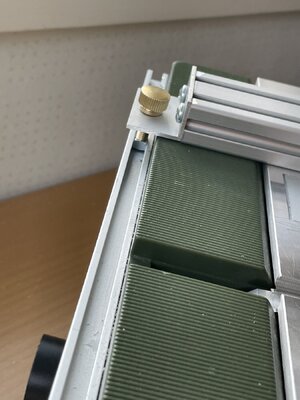
The thumb screw has a t-nut that runs along the rail at the back. I used the FET’s mitre fence to make the rail. The rail is attached to the back of the saw by drilling holes through the fence and screwing it on. There is just enough space to attach nuts from the inside.
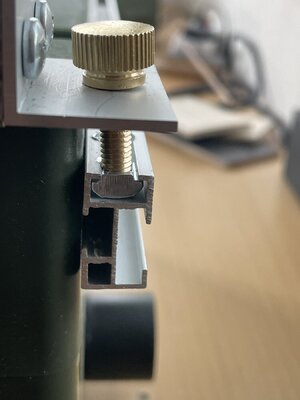
NOTE: The whole fence assembly needs to clear the table for opening the saw and changing blades:
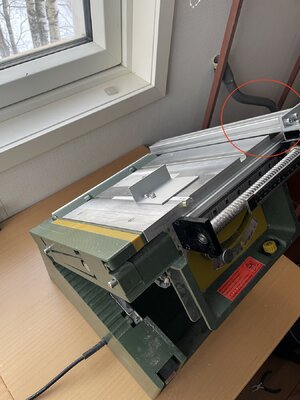
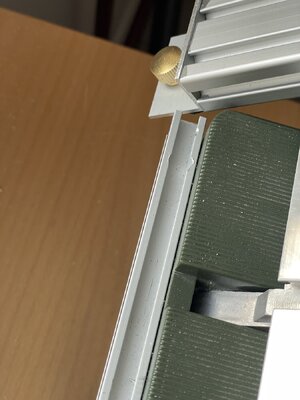
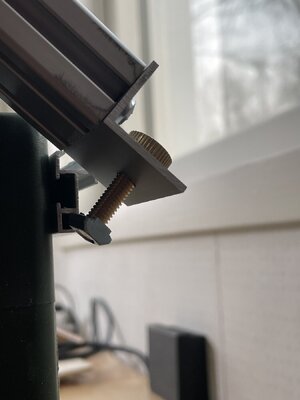
The simplest part is attaching the digital caliper. I sawed off the jaws and attached it with simple bracket and M4 screws to the underside of the linear rail. It slides along with the fence allowing for easy adjustment of cuts. It only take seconds to adjust the width of the cut!

I hope this is of some use!!

I’m sharing pictures of my Proxxon FET saw fence upgrade.

For the longest time I’ve been driven crazy by the inability to get consistently even cuts with the saw, or to be able to quickly and reliably adjust the width of the cut.
The heart of the upgrade is this:
Befenybay 200mm linear rail

I used the 200mm NEMA 17 -version, but even the 250mm version should fit. As a CNC linear rail it is very accurate and has zero play in the screw thread. For my purposes the electric motor was not necessary so I removed it.
ASSEMBLY:
I’m afraid I only have pictures of the finished upgrade, but I’ll try and explain the process.
I removed the Proxxon FET fence and gauge assembly, removed the yellow front plate and sawed off the brackets using an angle grinder.

Using graph paper lightly glued to the back of the front plate, I marked and then drilled the holes for the linear rail.
The linear rail has t-nuts at the back which make it very easy to attach and slide into the right position.

Some of the green plastic of the top cover has to be removed for it to fit, but it does not affect the integrity of the green plastic cover.

I have no use for angled cuts and only want guaranteed square cuts, so I removed the black adjusting wheel and tightened it square with a nyloc nut. By removing the height locking screw I am also able to get more height when using a 50mm saw blade.

Note that the rail has to fit all the way past the table so that the fence is clear of the table when opening the cover (for changing blades etc):

The linear rail sits very nicely under the table. The gap between the top of the rail and the table is almost exactly 15mm.
I attached a piece of standard 15x25mm steel tubing to the rail using M4 screws, and then made M4 screw holes on the top of the tubing for the L-bracket for the fence.

The fence itself is a length of aluminium rail which is guaranteed straight, but it could be any straight piece of metal.
At the other end of the fence is another bracket for the tightening thumb screw M6 to lock down the fence. The thumb screw is perhaps not strictly necessary as there is no play in the linear rail, but it gives extra reliability when cutting:

The thumb screw has a t-nut that runs along the rail at the back. I used the FET’s mitre fence to make the rail. The rail is attached to the back of the saw by drilling holes through the fence and screwing it on. There is just enough space to attach nuts from the inside.

NOTE: The whole fence assembly needs to clear the table for opening the saw and changing blades:



The simplest part is attaching the digital caliper. I sawed off the jaws and attached it with simple bracket and M4 screws to the underside of the linear rail. It slides along with the fence allowing for easy adjustment of cuts. It only take seconds to adjust the width of the cut!

I hope this is of some use!!








